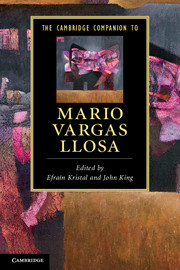Book contents
- Frontmatter
- Introduction
- 1 Reality and rebellion: An overview of Mario Vargas Llosa’s literary themes
- 2 The early novels: The Time of the Hero and The Green House
- 3 The total novel and the novella: Conversation in The Cathedral and The Cubs
- 4 Humour and irony: Captain Pantoja and the Special Service and Aunt Julia and the Scriptwriter
- 5 The historical novel: The War of the End of the World
- 6 Innocence and corruption: Who Killed Palomino Molero? and The Storyteller
- 7 The political novels: The Real Life of Alejandro Mayta and Death in the Andes
- 8 The erotic novels: In Praise of the Stepmother and The Notebooks of Don Rigoberto
- 9 The dictator novel: The Feast of the Goat
- 10 From utopia to reconciliation: The Way to Paradise, The Bad Girl and The Dream of the Celt
- 11 The essays
- 12 The memoir: A Fish in the Water
- 13 The plays
- 14 Film and the novels
- 15 An interview
- Further reading
- General index
- Index of selected fictional characters
- Index of selected works by Vargas Llosa
14 - Film and the novels
Published online by Cambridge University Press: 28 January 2012
- Frontmatter
- Introduction
- 1 Reality and rebellion: An overview of Mario Vargas Llosa’s literary themes
- 2 The early novels: The Time of the Hero and The Green House
- 3 The total novel and the novella: Conversation in The Cathedral and The Cubs
- 4 Humour and irony: Captain Pantoja and the Special Service and Aunt Julia and the Scriptwriter
- 5 The historical novel: The War of the End of the World
- 6 Innocence and corruption: Who Killed Palomino Molero? and The Storyteller
- 7 The political novels: The Real Life of Alejandro Mayta and Death in the Andes
- 8 The erotic novels: In Praise of the Stepmother and The Notebooks of Don Rigoberto
- 9 The dictator novel: The Feast of the Goat
- 10 From utopia to reconciliation: The Way to Paradise, The Bad Girl and The Dream of the Celt
- 11 The essays
- 12 The memoir: A Fish in the Water
- 13 The plays
- 14 Film and the novels
- 15 An interview
- Further reading
- General index
- Index of selected fictional characters
- Index of selected works by Vargas Llosa
Summary
Carlos Fuentes famously noted that once the sombre complexities of Mario Vargas Llosa's second novel, The Green House (La casa verde, 1966), are shed to their bare bones, they can be boiled down to one of the standard plots of the Mexican cinematic melodrama: a housemaid ends up in a house of prostitution. Indeed, Vargas Llosa's narrative fiction, from his first novel through to his last, features cinematic techniques and themes; and his formal experimentation with spatial and temporal planes, flashbacks and cuts, draws significantly on cinematic montage, as well as an awareness of effective camera angles to suggest a particular point of view. Film also provides the cinematic inspiration for some of his most stunning literary moments. For instance, the opening of Conversation in The Cathedral (Conversación en La Catedral, 1969), in which Santiago Zavala is searching for his dog, was probably inspired by a famous sequence from Vittorio de Sica's Umberto D (1952), in which a desperate Umberto pursues his dog Flike. While some other major Latin American writers, most notably Manuel Puig, have written skilful novels, which can be transformed into screenplays with ease (in some cases because the original draft was a screenplay), Vargas Llosa adapts some filmic techniques from a visual to a linguistic medium, to produce original literary effects that cannot be readily transferred back to the screen.
Cinema also features in the content of Vargas Llosa's novels, playing a crucial part in the novels themselves: in rites of socialisation and in the romances of his contemporary characters. In The Bad Girl (Travesuras de la niña mala, 2006), for example, a traumatised young woman (the bad girl of the title) eventually accepts the love of Ricardo Somocurcio, whose patience is tried in every chapter of the book. In the opening chapter, Ricardo declares his love to her during a Sunday matinee show in the more expensive orchestra seats of a movie theatre in Lima.
- Type
- Chapter
- Information
- The Cambridge Companion to Mario Vargas Llosa , pp. 199 - 211Publisher: Cambridge University PressPrint publication year: 2011

